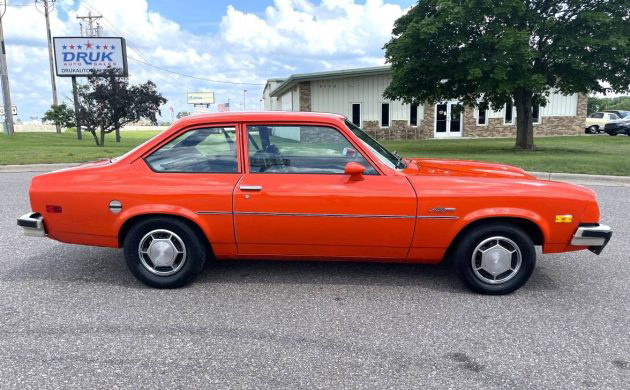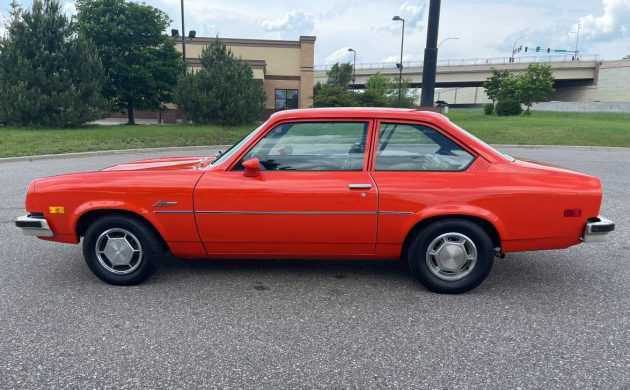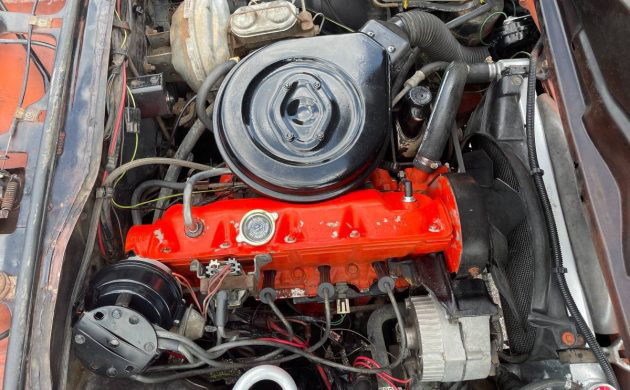Pontiac’s 1976 brochure states: “Our goal for the 1976 Astre was to come up with a little car you can feel at home in.” This example checks that box for me, for a whole host of reasons. I found this 1976 Pontiac Astre here on Craigslist in Anoka, Minnesota for an asking price of $8,988.
If you can’t tell, the Astre was Pontiac’s take on Chevrolet’s Vega. My grandfather was a Pontiac loyalist. so I tend to favor their offerings over any of their GM siblings’. Except for the Cosworth, my preference for Pontiac applies to the mid-70s subcompacts, even though I never see them — at shows, for sale, or on forums. That’s why I had difficulty believing nearly 150k were built over a 3-model-year run. They were offered in notchback, hatchback, and wagon form. This is one of the 18,143 examples of the 1976 notchback built.
I’m a fan of bold colors on simple cars and this one doesn’t disappoint. It appears to be Carousel Red, one of a few bright color options for the 1976 Astre. The seller’s claim of the body being in “excellent condition, straight and solid” looks to be spot on. Hopefully one of our informed readers can weigh in on the wheels — I recall these being offered on the Sunbird, but not the Astre. There is a matching spare in the trunk. so maybe my middle-aged memory is slipping.
The “standard interior” furthers that bold look with the factory plaid inserts. While there were options for “custom buckets” and “luxury buckets.” the vinyl/plaid works well on this orangeish-red notchback. The split-console look features a floor-mounted shifter below the dash and parking brake and cubby between the seats. Those seats and carpet look to be in very good condition and the dash seems to have held up fairly well over the past 48 years.
A 140 cubic-inch 4-cylinder sends power to the rear wheels via a floor-shifted Turbo-Hydramatic 3-speed automatic transmission. The odometer shows 45,603 miles which the seller believes to be actual. This Astre is equipped with factory air conditioning, but it is not currently blowing cold. The seller tells us the “wipers work, radio works…headlamps work” and the “tires are like new.”
I think the “at-home feeling” for me is captured in this Astre’s simplicity and excellent, original condition. Does this one meet Pontiac’s goal of making you feel at home? Or is it just another little car?








That is exactly the same model year of car and configuration as the one my parents had. They had a 1971 Ford Pinto (automatic) which ended being sold to a neighbor across from us. The 1976 Astre was the car my parents bought used, to replace the Pinto they sold. The only difference being, the Astre was equipped with a manual transmission. And a three speed manual transmission at that, when most manual transmission equipped Vegas (the corporate twin) and Astres were the much more common four speed variety. My mother didn’t know how to drive a manual transmission car. The was for her to learn, which never panned out, so my dad ended up being the sole driver. Like the car featured above, it was a two door notchback. And the colour was more of a burgundy red exterior with matching burgundy red interior seats but black instrument panel and steering column. There’s did not have A/C, power steering, power brakes and automatic transmission like the one featured above. The paint colour of the engine paint looks to be extremely well kept or preserved. Sadly, these cars were notorious for so many reliability issues. They leak oil. They rust. Sometimes won’t start for various reasons. That aluminium block, cast iron cylinder head engine ran with loud valve train noises from what I remembered. That car gave my parents problem after problem. They eventually gave it to my mother’s older brother if I remember correctly.
As an avid reader and member of “Barn Finds” I am excited to see when something I own makes it on to their wonderful site. Unfortunately it sold on Monday of this week. It happens to be a wonderful car. AC, AT, sport mirrors, power steering and power brakes. What more could you get with this car? The paint was in really wonderful shape. Sorry folks, but we had several callers in that week that we had it for sale here at Druk Auto LLC.
Thank you so very much Barn Finds.
My high school classmate bought a used vintage of this as a Vega. In addition to PS, PB, AC and AT it had a trailer hitch! Rationale was he was buying something newer that would still have value after his loan was paid off. Can’t imagine it worked out too well for him.
I forgot two more options that I forgot to mention. Bumper strips and the deluxe wheel covers.
To see one of the notchback Vega knockoff in such incredible shape at 45,000 miles, must mean that spinster Aunt Ethel’s keys were taken away in the late 70’s and this thing was mothballed in very dry and clean surroundings.
Doesn’t this car still have the dreaded 2.3 aluminum block and head engine or is it the 150ish cubic inch Iron Duke?
Definitely the Vega aluminum/cast iron engine. Ugh!
One of the Vega engine problems rarely discussed is the manner in which the aluminum/silicon alloy block was cast. Unlike other aluminum block engines of the era (Alfa Romeo, etc,) which were sand cast, the Vega block was low pressure diecast.
Having been involved with the supply of pressure diecasting tooling at GM’s former casting plant in Messena, NY in the early 1970’s. I am familiar with some of the problems that were encountered. While the molten metal in a sand cast block cooled slowly, the Vega’s low pressure diecast block was rapidly cooled in a watercooled die and quickly ejected allowing a much higher production rate. Areas of the block having greater mass required longer cooling times than thin wall sections. The different cooling rates resulted in porosity in some areas with resultant oil and/or water weeping of a completely built engine. The porosity may also explain early reports of block failure (block distortion during use was primarily attributed to overheating due to an inadequate cooling system).
In addition to the die cooling problem there were also problems with excessive wear on the H21 tool steel die sprues and core pins caused by the erosive effect of the molten aluminum alloy. These problems were partially countered by the strategic employment of Mallory 1150, a machinable W,Ni,Fe Mo powder metal product having higher thermal conductivity and greater resistance to wear than tool steel. The Vega 2300 aluminum engine was replaced by the Iron Duke 2.5L 4cyl. in 1977.
JGD, thanks for this info. Do you know if Chevy corrected this issue any time during the engine production? You do mention a counter-measure, but how far into production did this come and did it help with engine reliability?
The Iron Duke made its debut the following year. A huge improvement.
The Durabuilt version of this engine that came out for the 1976 model year was very good. Many, many examples ran over 150k
General Motors Syndrome, the last of the run is rock solid but by that time the model’s reputation has been ruined by the hugely popular and defect-filled early models so nobody was still buying.
My mother had a 76 Vega GT 5spd with the Dura Built. It was a great little car that gave her great service! She bought it at the time because GM was offering 5 years or 60,000 mile warranty on all engine components. She never needed to cash in on that.
Although, I have always loved those Pontiac taillights.
You seldom see an Astra two door sedan. This one is well equipped with auto, air and radio. That plaid cloth made the rounds that year finding its way into these, Vegas, Novas and Olds F-85s. Creampuff.
These Astre notchbacks must be scarce. I’ve never seen one.
Ok , I am ready for the outcry, but I have to say it!
Perfect for an LS swap !!!!!!!!!!
What a street sleeper she would be.
Isn’t everything
Where are you going to find a compact in like-new condition for that price? And it’s not a beater!
Yeah, it’s a Vega, but I always thought that the upmarket versions of GM’s economy cars always added a bit of classiness that the Chevys lacked.
I bought one of these , a 76′, as a work beater in the early 80’s. Unlike a previous Vega I owned, it didn’t exhibit the oil – burning tendencies that car had, even though it had the aluminum block. But, the automatics were known for having the torque converter bolts shear off unexpectedly. There were only three (3) bolts on there. Other than that, it possessed every GM ” technology” item that could possibly fail. It was the last GM vehicle I owned, 42 years ago. Just sayin’…
All L can say is today B/F has really knocked it out of the park for me almost every listing from the 62 Corvette has stuck a nerve with me.
I had a handful of monzas, Starfire’s, and Skyhawks. If you can find a V/8 monzas, they’re a blast for little money
A Vega, by any other name, is still a Vega.
Yes but, no.
Nice looking car. Although I was way too young at the time to drive a car, I remember cars like this Pontiac Astre. I also remember similar cars like the Chevy Vega. I don’t know which I’d drive if given the chance. I was told growing up that these were pieces of crap, not very good quality cars. I was born in 1973, so there’s no way I would’ve known how a car fared during a lifetime of ownership.